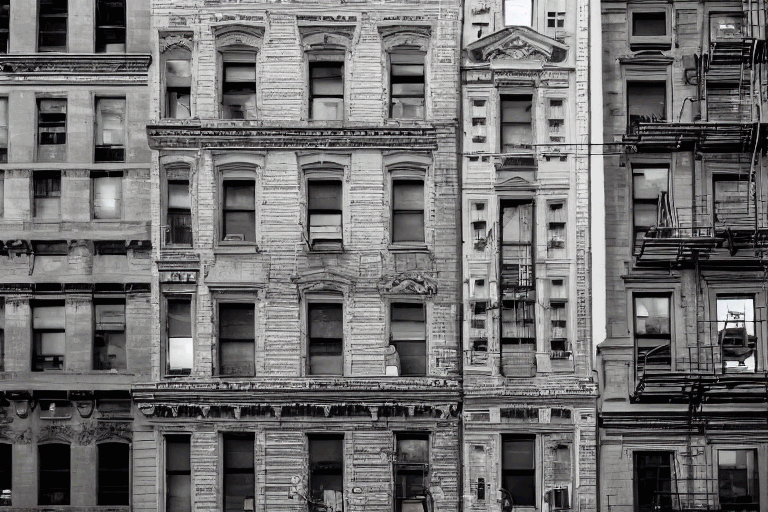New York City is filled with a remarkable and diverse array of architectural styles, from the skyscrapers and modern high-rises of Manhattan, to the small town-style homes in the outer boroughs.
But it is the city’s old architecture that makes it truly stand out from any other place in the world. From the grand Beaux-Arts buildings of the late 19th and early 20th centuries, to the brownstones and Italianate style houses of the pre-war era, to the pre-industrial warehouse buildings and manufacturing plants, the city’s old architecture gives a unique glimpse into its past.
The city’s oldest buildings are concentrated in Manhattan, particularly in the Lower Manhattan area, where the original Dutch settlers built many of the city’s first churches, banks, and government buildings.
Further north, many of New York’s older structures can be found, including former warehouses now used as luxury condominiums, and the earliest skyscrapers, such as the Flatiron Building, at the corner of Fifth Avenue and Broadway.
In Brooklyn, the city’s second-largest borough, old architecture stretches from Park Slope to Williamsburg and beyond, reflecting the borough’s mix of Dutch and English colonial styles, as well as its influential Scandinavian influences.
Other old structures, such as the Pratt Institute in Brooklyn, are reminders of the city’s industrial history. In Queens, old architecture ranges from the early Dutch and English colonial styles, to 19th-century Italianates and row homes, to 20th-century bungalows, to more modern housing developments.
The Bronx’s old architecture mirrors the urban texture and grandeur of Manhattan, from the grand old churches, to the historic landmarks such as Yankee Stadium, to the humbler brick rowhouses and pre-war apartment buildings.
Finally, Staten Island’s oldest architecture consists primarily of Victorian-era homes and mansions, as well as a handful of early industrial buildings.
Whether it’s a grand brownstone in Brooklyn, an old warehouse in the Bronx, or a historic home in Staten Island, the old architecture of New York City stands as a testament to the city’s vibrant history.
The City Hall, built in 1812, is another example of old architecture in New York City. The iconic building is the oldest city hall in the U.S. and is also a National Historic Landmark. It is made of white marble and has a 306-foot (93-m) high dome, which is the tallest masonry dome in the world.
The Woolworth Building, constructed in 1913, is the world’s tallest building at the time of its completion. The 792-foot (241-m) building was designed in the neo-Gothic style by architect Cass Gilbert and is one of the oldest skyscrapers in Manhattan.
The historic St. Paul’s Chapel, built in 1764, is the oldest surviving church in Manhattan. The Georgian style church was designed by Thomas McBean and is best known for its role in the aftermath of the September 11 terror attacks.
The historic cast-iron Building at 8 Spruce Street, located in the Financial District, was built in 1932. The 65-story structure is located just two blocks away from the Woolworth Building and is one of the tallest residential buildings in the world.
New York City offers an impressive array of old and new architecture. From iconic landmarks-built centuries ago to more modern structures, the city is a testament to the country’s great architectural heritage.
New York City is home to some of the most iconic and historic architecture in the United States. The city has buildings dating back to the 1600s, and its City Hall, the first built in the U.S., is one of the oldest in the nation.
In addition, New York City is home to the country’s largest concentration of skyscrapers, some of which are widely recognized throughout the world.
In recent years, architects and city planners have put a renewed emphasis on preserving and restoring some of the most iconic of these old structures, both for historical and aesthetic reasons.
In particular, the South Street Seaport Historic District has undergone extensive restoration and project planning to protect the area and its buildings from gentrification and urban renewal projects.
Other well-known and iconic buildings that have been restored in recent years include the Flatiron Building, the Empire State Building, the Woolworth Building, and the former World Trade Center buildings.
New York City is also home to some of the most iconic modern buildings in the world, including the now-historic Empire State Building, the Freedom Tower, the New York Times Building, and the Hearst Tower.
Many of these iconic buildings reflect the pioneering use of steel and glass for construction, as well as their integration of iconic geometric shapes, creative use of modern materials such as titanium, and extensive sustainability efforts.
Overall, the variety of old and new architecture in New York City makes it a unique and captivating place to visit and explore. The city is an amazing testament to the progress that has been made in architecture over the centuries, with both classical and modern structures used to create a truly inspiring cityscape.
Conclusion/Final Word/Final Thought:
The old architecture of New York City is an important part of the city’s rich and ever-changing history.
It serves to remind us of the past and the people who have contributed to the city’s development. Although some of the old buildings have been replaced by modern structures, many of them still stand tall and proud, offering a unique reminder of New York City’s past.
Whether it’s a stately mansion in the Upper East Side or a historic brownstone in Brooklyn, the old architecture of New York City will always be remembered and celebrated.

